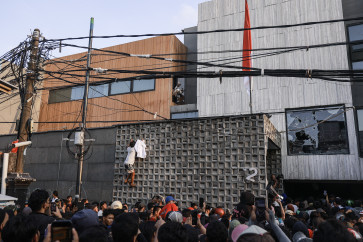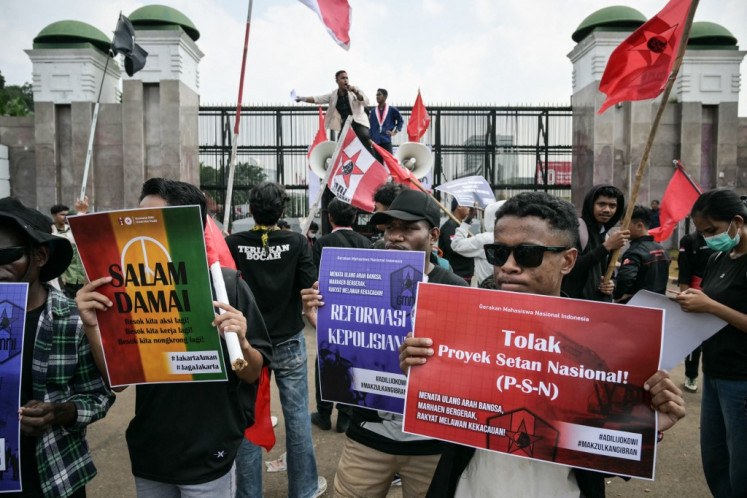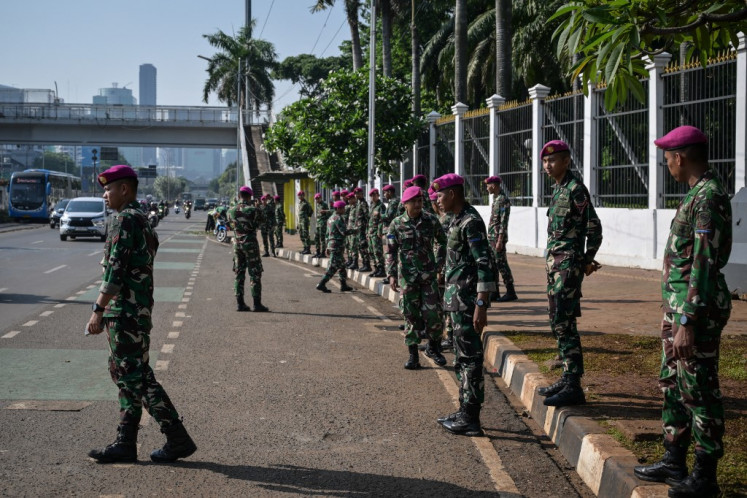Popular Reads
Top Results
Can't find what you're looking for?
View all search resultsPopular Reads
Top Results
Can't find what you're looking for?
View all search resultsLearning history in a digital museum
Historic building: The museum is on the grounds of Fort Vredeburg, one of the cityâs most famous tourist destinations
Change text size
Gift Premium Articles
to Anyone
Historic building: The museum is on the grounds of Fort Vredeburg, one of the city's most famous tourist destinations.
Hadi Prasetya looked at a 29-inch touch screen LCD monitor under minimal lighting in a Dutch colonial era building. The 10-year-old was not watching a soccer match. He was reading about the history of the Linggarjati Agreement.
The student said that he was interested by the small boxes to the left and right of the monitor that showed cartoons or told new stories at the click of his finger.
More than 50 similar monitors exist at the museum on the grounds of Fort Vredeburg, one of the city's most famous tourist destinations, built in 1756 to protect Sultan Hamengkubuwono I, whose palace is just to the south.
Museum official Suryanta Pamuji said that the monitors aimed to entice visitors to read and learn about the history of Indonesia, where a culture of watching remains stronger than that of reading. Monitors also provided information to help guests learn more about the 55 historical dioramas in the museum.
The simulacra represent everything from Prince Diponegoro's War (1825-1830) to the moment when Soeharto formulated P4 training, to internalize the national political philosophy of Pancasila, in 1974.
'We have been equipping our museum with touch screen monitors from 2011 to 2013. This year, we will add new monitors in Building G. All monitors were financed by the government through the state budget,' he said.
The displays present information in interesting ways, featuring colorful text and elaborate fonts ' not to mention the cartoons.
Wired: The museum spent two years installing more than 50 interactive monitors.
On the screen seen by Hadi, for example, two paragraphs, under the title 'Info Diorama', told about the medical aid given by the Egyptian government to a newly independent Indonesia after the signing of the Linggarjati agreement between the Indonesian and Dutch governments on March 25, 1947.
On the left, three smaller screens told stories about diplomat Haji Agus Salim, the bilateral partnership between Indonesia and Egypt and Egyptian aid to Indonesia.
On the right, two small screens offered stories about the recognition of Indonesian independence in the Middle East and Europe.
At the top of the touch screens, buttons labeled with the flags of Indonesia and the US offered text in different languages.
'Many foreign visitors visit Fort Vredeburg. Therefore, we provide English text to accommodate them,' Suryanta said.
Museum management also provides an interactive game area and two mini-movie theaters, offering historical fare such as the Independence War films Janur Kuning (Young Yellow Coconut Leaves), Serangan Fajar (Dawn Raid) and Bandung Lautan Api (Bandung, Sea of Fire); the contemporary biopic Sang Pencerah (The Enlightener), about the founder of Muhammadiyah, the nation's second largest Muslim social organization; as well as military documentaries.
Visual: A museum official says the monitors and dioramas are keyed to a visual, rather than textual, experience.
'[Visitors] can also surf the Internet, because we have a free hotspot area,' said Suryanta, who has worked at the Vredeburg Fort since 1993.
When firstly entering the museum, visitors will hear patriotic songs such as 'Indonesia Raya' (Great Indonesia), 'Garuda Pancasila', 'Satu Nusa Satu Bangsa' (One Island, One Nation), 'Bagimu Negeri' (For You, My Country) and 'Bangun Pemuda Pemudi' (Rise, Youth).
Some visitors looked excited, while others, mostly lovebirds, preferred to sit on stone benches under shade trees, taking 'selfie' pictures near antique cannons and hero statues.
In the buildings, visitors also took photos near dioramas, photos, paintings and statues of National Heroes such as Independence activist Ki Hadjar Dewantara and women's rights pioneer Raden Ajeng Kartini, as well as authentic relics, such as the bed, table and chairs used by Gen. Soedirman in Yogyakarta in 1949.
Suryanta said that the number of visitors to the museum, which is open from Tuesday to Sunday, has been increasing, topping 250,000 as of October 2014.
'Our hope is simple. We just want that sense of nationalism owned by the Indonesian people, especially the young generation, to become stronger after they visit this museum,' he said.
On display: The displays provide info on everything from the Prince Diponegoro War (1825-1830) to the moment Soeharto formulated P4 training in 1974.
' Images by A. Kurniawan Ulung













